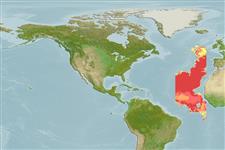>
Gadiformes (Cods) >
Macrouridae (Grenadiers or rattails)
Etymology: Echinomacrurus: Greek, echinos = sea urchin, hedgehog + Greek,makros = big + Greek, oura = tail (Ref. 45335).
Environment: milieu / climate zone / depth range / distribution range
Ecologia
marinhas batipelágico; intervalo de profundidade 4000 - 6000 m (Ref. 557). Deep-water; 55°N - 6°S, 40°W - 15°W
North Atlantic: northeast of Mid-Atlantic Ridge, east of Great Meteor Tablemount.
Tamanho / Peso / Idade
Maturity: Lm ? range ? - ? cm
Max length : 46.5 cm TL macho/indeterminado; (Ref. 37108)
Descrição suscinta
Chaves de identificação | Morfologia | Morfometria
Band of small pointed teeth in both jaws. Body light brownish to olivaceus green (Ref. 37108).
Inhabits bathypelagic to benthopelagic (Ref. 37108).
Ciclo de vida ou comportamento de acasalamento
Maturities | Reprodução | Spawnings | Egg(s) | Fecundities | Larvas
Wheeler, A., 1977. Das grosse Buch der Fische. Eugen Ulmer GmbH & Co. Stuttgart. 356 p. (Ref. 557)
Status na Lista Vermelha da UICN (Ref. 130435)
Ameaça para os humanos
Harmless
Uso pelos humanos
Pescarias: sem interesse
Ferramentas
Relatórios especiais
Baixar XML
Fontes da internet
Estimates based on models
Preferred temperature (Ref.
123201): 2.3 - 2.6, mean 2.4 °C (based on 682 cells).
Índice de diversidade filogenética (Ref.
82804): PD
50 = 0.7500 [Uniqueness, from 0.5 = low to 2.0 = high].
Bayesian length-weight: a=0.00219 (0.00111 - 0.00431), b=3.20 (3.03 - 3.37), in cm total length, based on LWR estimates for this (Sub)family-body shape (Ref.
93245).
Nível Trófico (Ref.
69278): 3.2 ±0.45 se; based on food items.
Resiliência (Ref.
120179): Baixo, tempo mínimo de duplicação da população 4,5 - 14 anos (Preliminary K or Fecundity.).
Fishing Vulnerability (Ref.
59153): Moderate vulnerability (37 of 100).
